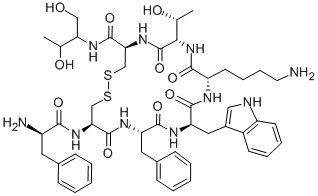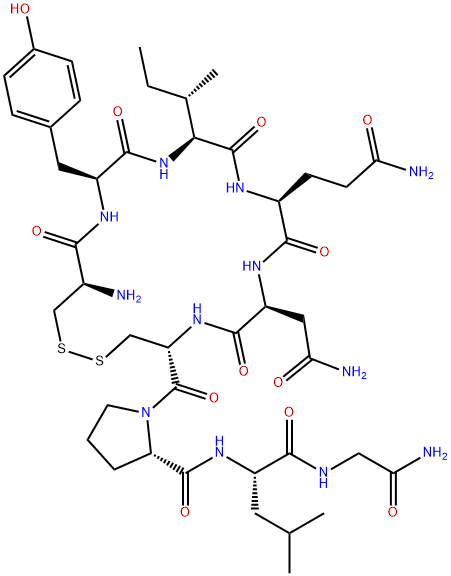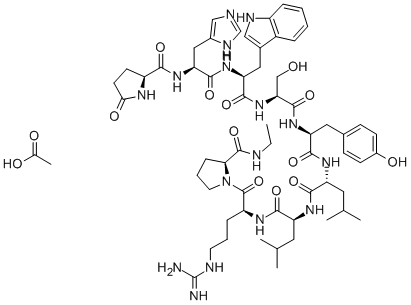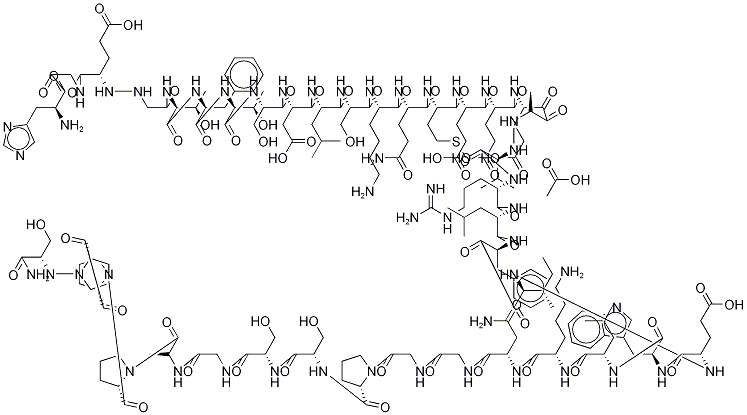Octreotide acetate
Synonym(s):Octreotide acetate salt
- CAS NO.:83150-76-9
- Empirical Formula: C49H66N10O10S2
- Molecular Weight: 1019.24
- MDL number: MFCD07780622
- EINECS: 1533716-785-6
- SAFETY DATA SHEET (SDS)
- Update Date: 2025-12-26 12:07:08

What is Octreotide acetate?
Description
Octreotide is a long-acting somatostatin analog indicated for symptomatic control in acromegaly and gastroenteropancreatic tumors. Other potential uses under investigation include diabetes, psoriasis and Alzheimer's disease.
Originator
Sandoz (Switzerland)
The Uses of Octreotide acetate
Octreotide Acetate is the acetate salt of a synthetic long-acting cyclic octapeptide with pharmacologic properties mimicking those of the natural hormone somatostatin. It inhibits the secretion of growth hormone, glucagon, insulin, gastrin, vasoactive intestinal peptide, secretin, motilin and pancreatic polypeptide. Octreotide acetate was uses for the treatment of severe diarrhea and flushing associated with malignant carcinoid tumors, acromegaly, and diarrhea associated with VIPoma; and, then in 2010, for the treatment of neuroendocrine tumors.
Indications
Octreotide acetate (Sandostatin) is a synthetic peptide analogue of the hormone somatostatin. Its actions include inhibition of the pituitary secretion of growth hormone and an inhibition of pancreatic islet cell secretion of insulin and glucagon. Unlike somatostatin, which has a plasma half-life of a few minutes, octreotide has a plasma elimination half-life of 1 to 2 hours. Excretion of the drug is primarily renal.
brand name
Sandostatin (Novartis).
Therapeutic Function
Antiulcer, Growth hormone inhibitor
Biological Functions
Octreotide acetate, a long-acting octapeptide analogue of somatostatin, has a half-life of approximately 100 minutes. A comparison of the primary structures of octreotide and somatostatin suggests little similarity, but from earlier work at the Salk Institute it was known that not all the residues in somatostatin were necessary to elicit its full biological activity. Other studies suggested that the essential fragment for its activity was the tetrapeptide Phe7-Trp8- Lys9-Thr10. These earlier studies helped in the design of the potent drug now known as octreotide acetate. This drug suppresses the secretion of gastroenteropancreatic peptides, such as gastrin, vasoactive intestinal peptide (VIP), insulin, and glucagon, as well as pituitary GH. Furthermore, it is more potent than natural somatostatin in inhibiting the release of glucagon, insulin, and GH.
General Description
Octreotide is a somatostatin analogue with D-Phe-Cys-Phe-D-Trp-Lys-ThrCys-Thr-OH amino acid sequence.
Biochem/physiol Actions
Octreotide is three times more potent than the native hormone in inhibiting the secretion of growth hormone glucagon and insulin in vivo. Octreotide regulates serum prolactin levels and resolves galactorrhea or (secondary) amenorrhea in acromegaly patients. Hence, this peptide can be considered as a potent therapeutic for acromegaly treatment.
Clinical Use
Octreotide acetate(83150-76-9) is used by SC injection in the palliative treatment of patients with metastatic carcinoid tumors, which are tumors of the endocrine system, GI tract, and lung (gastroenteropancreatic). Carcinoid tumors secrete increasing amounts of vasoactive substances, including histamine, serotonin, bradykinin, and prostaglandins. Octreotide acetate inhibits or suppresses the release of these vasoactive substances and, thus, is useful in treating the severe diarrhea, facial flushing, and wheezing episodes that accompany carcinoid tumors. In addition, it finds use in the palliative management of VIP-secreting tumors (VIPomas, usually pancreatic tumors). Patients with VIPomas suffer a profuse, watery diarrhea syndrome, and octreotide acetate is able to help by decreasing the release of damaging intestinal tumor cell secretions. Octreotide also helps to reduce hypokalemia by correcting electrolyte imbalances.
An excessive secretion of GH from the pituitary can cause the disorder known as acromegaly, which is characterized by a progressive enlargement of the head, face, hands, feet, and thorax. Inasmuch as octreotide acetate is able to decrease the secretion of GH from the pituitary, it is used in treating patients with acromegaly who are unresponsive to previous pituitary radiation therapy or surgery. It is used in the treatment of acromegaly, because it reduces the blood levels of both GH and insulin-like growth factor-I (IGF-I). The long-acting repository form of octreotide acetate also is used in treating acromegaly, carcinoid tumors, and VIPomas, but in monthly depot injections.
Octreotide for IV injection is used in the treatment of acute bleeding from esophageal varices. Variceal bleeding occurs in about half the patients with cirrhosis of the liver and is responsible for about one-third of deaths in these patients. Octreotide is a potent vasoconstrictor that reduces portal and collateral blood flow by constricting visceral vessels, which leads to reduced portal blood pressure and decreases the bleeding.
Side Effects
Some common side effects of octreotide acetate include cardiac conduction disorder, gallbladder sludge, hyperglycemia, cardiac arrhythmia, and hypoglycemia.
Octreotide acetate may cause serious side effects, and if any of these occur, you should contact your doctor immediately. These side effects include signs of gallstones, high blood sugar, low blood sugar, and underactive thyroid. Signs of gallstones include fever, chills, nausea, vomiting, severe pain in your upper stomach spreading to your back, dark urine, clay-colored stools, or yellowing of the skin or eyes. Signs of high blood sugar include increased thirst, increased urination, dry mouth, and fruity breath odor. Signs of low blood sugar include headache, hunger, sweating, irritability, dizziness, fast heart rate, and feeling anxious or shaky. Signs of underactive thyroid include extreme tiredness, dry skin, joint pain or stiffness, muscle pain or weakness, hoarse voice, feeling more sensitive to cold temperatures, and weight gain.
https://www.drugs.com/sfx/octreotide-side-effects.html
Veterinary Drugs and Treatments
Octreotide may be useful in the adjunctive treatment of hyperinsulinemia in patients with insulinomas (especially dogs, ferrets). Response is variable, presumably dependent on whether the tumor cells have receptors for somatostatin. Octreotide may also be useful in the diagnosis and symptomatic treatment of gastrinomas in dogs or cats. It may be of use in the treatment of acute pancreatitis, but more research is needed before it can be recommended for this use in veterinary patients.
Storage
Desiccate at -20°C
Mode of action
Octreotide acetate is a synthetic somatostatin analogue with similar pharmacologic effects to naturally occurring somatostatin, but with a prolonged duration of action. It inhibits pathologically increased secretion of growth hormone, thyroid stimulating hormone, and serotonin, insulin, glucagon, and other peptides produced within the gastro-entero-pancreatic endocrine system. Somatostatin is cell cycle phase-specific, mediating arrest at the G1- phase. Long acting somatostatin analogues have been shown to inhibit tumour growth.
Properties of Octreotide acetate
| Melting point: | >140°C (dec.) |
| Boiling point: | 1447.2±65.0 °C(Predicted) |
| Density | 1.39±0.1 g/cm3(Predicted) |
| storage temp. | -20°C |
| solubility | Soluble in acetic acid, DMSO, and methanol |
| form | Solid |
| pka | 12.60±0.70(Predicted) |
| color | White to Off-White |
| Water Solubility | Soluble to 1.20 mg/ml in water |
| Stability: | Hygroscopic |
| CAS DataBase Reference | 83150-76-9 |
Safety information for Octreotide acetate
Computed Descriptors for Octreotide acetate
| InChIKey | DEQANNDTNATYII-MEUDYGGUSA-N |
New Products
4,4-Difluoropiperidine hydrochloride tert-butyl 9-methoxy-3-azaspiro[5.5]undecane-3-carboxylate Indole Methyl Resin N-Isopropylurea N,N-Dicyclohexylcarbodiimide(DCC) MELDRUMS ACID 5-METHYLISOXAZOLE-4-CARBOXYLIC ACID Magnessium Bis glycinate Zinc ascorbate 1-bromo-2-butyne 2-acetamidophenol 9(10H)-anthracenone Erythrosin B, 4-Piperidinopiperidine 2-((4-morpholinophenylamino) (methylthio) methylene) malononitrile 2,4-dihydroxybenzaldehyde 3-(4-morpholinophenylamino)-5-amino-1H-pyrazole-4-carbonitrile Methyl 2-methylquinoline-6-carboxylate 2,6-dichloro-4-nitropyridine 4-Bromo-2-chlorobenzonitrile 2-(benzylamino)acetic acid hydrochloride 4-(tert-Butoxycarbonylamino)but- 2-ynoic acid 3,4-dihydro-2H-benzo[b][1,4]dioxepine 1-Phenyl-1-cycloprppanecarboxylicacidRelated products of tetrahydrofuran
You may like
-
 83150-76-9 octreotide 98%View Details
83150-76-9 octreotide 98%View Details
83150-76-9 -
 83150-76-9 98%View Details
83150-76-9 98%View Details
83150-76-9 -
 Octreotide 98%View Details
Octreotide 98%View Details
83150-76-9 -
 Octreotide 83150-76-9 98%View Details
Octreotide 83150-76-9 98%View Details
83150-76-9 -
 Octreotide CAS 83150-76-9View Details
Octreotide CAS 83150-76-9View Details
83150-76-9 -
 20677-73-0 (2,2-diethoxyethyl)methylamine 98%View Details
20677-73-0 (2,2-diethoxyethyl)methylamine 98%View Details
20677-73-0 -
 3-(4-(hydroxyamino)-1-oxoisoindolin-2-yl)piperidine-2,6-dione 98%View Details
3-(4-(hydroxyamino)-1-oxoisoindolin-2-yl)piperidine-2,6-dione 98%View Details -
 57381-49-4 2-bromo-4-chlorobenzonitrile 98%View Details
57381-49-4 2-bromo-4-chlorobenzonitrile 98%View Details
57381-49-4








